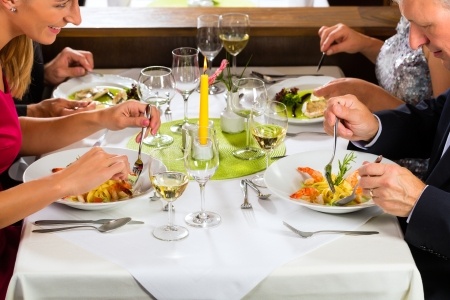Healthy eating and socializing usually don’t go hand-in-hand. Social dining typically entails restaurant dining with its excessive amounts of butter and oil and humongous portions.
There is also an undeniable social pressure elements that causes the diners to overeat. It starts with “appetizers for the table,” progresses to multiple rounds of drinks, and concludes with ordering quite a few desserts to share.
Healthy eating habits can be successfully maintained by only the most stringent healthy liver under these very common circumstances.
Is Healthy Eating Compatible with a Social Life?
Research consistently shows that people eat more when dining with friends and family. For this reason, dieters often make a conscious effort to avoid as many social situations as possible.
People eat more with friends and family than when dining alone. This may be a throwback to our early ancestors’ approach to survival, according to a new study. This phenomenon is known as “’social facilitation.”
Previous studies found that those eating with others ate up to 48% more food than solo diners and women with obesity eating socially consumed up to 29% more than when eating alone.
Experts at the University of Birmingham set out to find out what accounted for the vastly increased food intake in social situations:
- A team of researchers in Britain and Australia evaluated 42 existing studies of research into social dining.
- They discovered that eating “socially” has a powerful effect on increasing food intake relative to dining alone.
- They explain that ancient hunter gatherers shared food because it protected against periods of food insecurity.
- This survival mechanism may still persist today, leading to people eating more with friends and family because:
- Eating with others is more enjoyable and enhanced reward from social eating could increase consumption.
- Social norms might “permit” overeating in company but sanction it when eating alone.
- Providing food becomes associated with praise and recognition from friends and family, strengthening social bonds.
Why is Healthy Eating So Difficult Among Friends?
Research leader Dr Helen Ruddock, from the School of Psychology at the University of Birmingham, explains why healthy eating is challenging with friends:
- We found strong evidence that people eat more food when dining with friends and family than when alone.
- However, this social facilitation effect on eating was not observed across studies which had looked at food intake amongst people who were not well acquainted.
- People want to convey positive impressions to strangers. Selecting small portions may provide a means of doing so and this may be why the social facilitation of eating is less pronounced amongst groups of strangers.
- Findings from previous research suggest that we often choose what (and how much) to eat based on the type of impression that we want to convey about ourselves.
- Evidence suggests that this may be particularly pronounced for women eating with men they wish to impress and for people with obesity who wish to avoid being judged for overeating.
The study highlights that, as with many other species, humans tend to share a common food resource. Most humans are no longer hunter-gatherers, but mechanisms similar to those that once served efficient foraging continue to guide our dietary behavior.
Recent and rapid transition to a dietary landscape in which food is abundant has created forms of evolutionary mismatch — inherited foraging strategies no longer serve their former purpose.
Researchers note that, in the case of social facilitation, we have inherited a mechanism that once ensured equitable food distribution, but now exerts a powerful influence on unhealthy dietary intakes.
The same process has been observed in chickens, rats, gerbils and other species, suggesting it serves an ultimate purpose. Individuals compete for resource and research suggests that eating more than others is likely to lead to ostracism, which, in turn, reduces food security.
This creates a tension between an individual ‘being seen’ to share food altruistically and eat as much as they need.
“A solution to this tension may be to eat at least as much as others in the group — individual members match their behavior to others, promoting a larger meal than might otherwise be eaten in the absence of this social competition,” commented Dr Ruddock.
“What we describe as ‘social facilitation’ can be seen as a natural by-product of social food sharing — a strategy that would have served a critical function in our ancestral environments. This also explains why it is more likely to occur in groups with individuals who are familiar with each other.”
Click here to read full research study on healthy eating and social dining.






